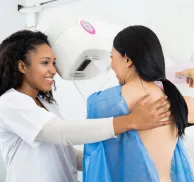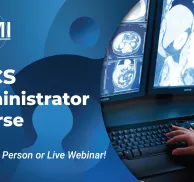In medical imaging, cross-training is a strategic investment with measurable returns for technologists, patients, and departments alike. In an era of staffing gaps and shifting demand across modalities, expanding your competence from X-ray to CT or MRI, adding mammography or ultrasound cross-training, or blending clinical skills with informatics can increase earning power or open doors to faster advancement, not to mention make you indispensable on your team. It also shortens patient wait times, strengthens collaboration between teams, and keeps work engaging by challenging you to learn and innovate.
So, what is cross-training? This guide breaks down the ways in which cross-training pays off — financially and professionally — while outlining practical paths to get started through focused, high-impact learning that avoids the cost and time of another degree.
Why Cross-Training Matters in Medical Imaging
Cross-training isn’t a “detour.” It’s a direct route to greater impact, mobility, and stability across today’s fast-moving imaging landscape. Specifically, this is why investing in additional skills pays off for both you and your department:
Adapting to a Rapidly Evolving Healthcare Environment
Imaging technologies, protocols, and patient volumes shift quickly. Cross-trained technologists can float where demand spikes, maintain throughput during staffing shortages, and help standardize best practices across units. You’ll speak the “language” of multiple modalities, which improves communication with radiologists and peers and accelerates problem-solving when equipment or scheduling challenges arise. The result is a department that’s more resilient, plus a technologist who remains current and in demand.
Expanding Career Opportunities
Adding a second or third modality expands your job options beyond a single unit, opening doors to roles like:
Lead tech
Educator/preceptor
Quality assurance (QA) specialist
Picture archiving and communication systems (PACS)/imaging informatics
Vendor applications
Multi-modality credentials also qualify you for premium shifts, cross-coverage differentials, and competitive travel or per-diem assignments. As you broaden your toolkit, you build a clearer path to supervisory and managerial roles because you understand workflows across the continuum. More than merely a way to add a letter after your name, cross-training multiplies the directions your career can go.
Increasing Job Security in a Competitive Market
When service lines fluctuate, multi-skilled technologists are often the first to be called in. Your ability to plug staffing gaps reduces overtime strain on colleagues and makes you invaluable to schedulers and leaders. Versatility also insulates you from local market shifts; if hiring slows in one area, your additional credentials keep opportunities open elsewhere. In short, cross-training strengthens your value proposition — making you harder to replace and easier to reward.
“You can’t talk about a staffing gap if you aren’t willing to build a bridge.”--Anonymous
The Many Forms of Cross-Training
What is cross-training in its various forms? Rather than a single pathway, cross-training entails a mix of complementary skill builds that let you flex where your team, your patients, and your career need you most.
Learning Additional Imaging Modalities
Adding a second or third modality deepens your clinical range and widens your scheduling options. Whether you move from general radiography into CT, build MRI proficiency, or add vascular or breast ultrasound cross-training, the process typically blends focused didactic learning with supervised clinicals and documented competencies. The payoff is practical: You can step into high-demand rooms, cover for others more confidently, and qualify for multi-modality roles that often come with differentials and faster advancement.
Combining Clinical Expertise With Administrative Skills
Pairing hands-on imaging with leadership and operations skills makes you invaluable beyond the scanner, in areas like:
Protocol management
Equipment QA
Workflow optimization
Scheduling
Onboarding and precepting
Policy development
Accreditation readiness
Add foundational informatics — basic PACS/radiology information system (RIS) skills, image routing, and troubleshooting — and you become a go-to bridge between front-line care, IT, and department leadership.
Gaining Experience in Both Inpatient and Outpatient Settings
Rotating between hospital and ambulatory environments sharpens adaptability. Mastering both settings improves clinical judgment, strengthens collaboration, and gives you more freedom to choose shifts and roles that fit your goals.
Inpatient work hones rapid triage, communication with ED/OR/ICU teams, and comfort with complex or unstable patients.
Outpatient work strengthens patient education and service consistency for scheduled exams.
Blending Patient Care Skills With Technology and Data Analysis
Modern imaging runs on people and data. Clinicians who can both read the room and read the dashboard are poised to lead quality initiatives and drive measurable improvements. Layering strong patient communication and safety practices with basic analytics helps you spot bottlenecks and refine protocols while elevating the patient experience. This may entail:
Repeat/reject tracking
Turnaround-time monitoring
Dose and contrast usage trends
AI-assisted workflow flags
The Tangible ROI of Cross-Training
Cross-training delivers measurable gains — for your paycheck, your schedule, and your long-term career momentum. Here’s where the return on investment (ROI) shows up:
Higher Earning Potential Through Multi-Modality Certification
Many facilities now post roles specifically for multi-modality technologists, which can lift hourly rates while broadening advancement paths. Thus, adding industry cross-training to your toolkit often qualifies you for higher base pay, multi-modality differentials, premium shifts, and call pay.
Greater Flexibility in Scheduling and Job Placement
When you can staff multiple rooms, schedulers have more options, and so do you. Cross-trained technologists can mix inpatient and outpatient shifts, secure consistent hours during fluctuations in patient volume, and tap per-diem or travel assignments without starting from scratch in a new specialty.
Faster Career Progression Into Specialized Roles
Competency across modalities accelerates your readiness for more advanced lead tech, educator, QA, or imaging informatics roles. You’ll understand protocols and safety from multiple angles, making you a stronger candidate for promotions and special projects.
Reduced Downtime and Increased Shift Coverage Opportunities
Versatility keeps scanners running and reduces bottlenecks. If a modality surges or a teammate calls out, you can step in to support colleagues and productivity as well as even earn extra pay through short-notice coverage or overtime.
Student Debt Avoidance
Cross-training via focused courses and structured on-the-job learning builds marketable skills without the cost and time of another degree. Short, accredited programs and CE pathways (often supported by employer reimbursement) let you upskill quickly while staying employed, in turn minimizing tuition spend and lost wages.
Increased Job Satisfaction and Engagement
Variety combats burnout. Rotating across modalities, taking on precepting or QA tasks, and seeing your skills tangibly improve patient flow and outcomes boosts motivation and pride in your work — key ingredients for long-term retention and career fulfillment.
Fostering Innovation
Working across modalities exposes you to different protocols, teams, and technologies, sharpening problem-solving and adaptability. Driving continuous improvement that benefits patients and departments alike, cross-trained technologists spot patterns in repeat/reject rates, dose metrics, or scheduling gaps and help implement fixes.
How Cross-Training Improves Patient Care
When technologists understand multiple modalities and workflows, patients experience the benefits of cross-training in speed, safety, clarity, and overall experience.
Providing a Continuity of Care Across Modalities
Cross-trained technologists carry a patient’s story from one exam to the next — aligning positioning, history, and safety checks (e.g., implants, contrast considerations, pregnancy status) across modalities. Consistent education and reassurance reduce anxiety, while seamless handoffs minimize repeat imaging and keep care plans moving forward.
Reducing Wait Times by Increasing Workforce Versatility
When volume spikes or staff call out, multi-skilled technologists can step in to keep rooms open and schedules on time. The ability to float between CT, MRI, ultrasound, mammography, or general radiography reduces bottlenecks, same-day add-on delays, and costly reschedules — so patients get answers sooner.
Enhancing Collaboration Between Imaging Departments
Technologists “fluent” in more than one modality help align protocols, standardize prep requirements, and troubleshoot issues before they ripple across the department. Improving throughput and decreasing errors from fragmented workflows, they bridge communication among staff in areas like:
Front desk
Nursing
Radiologists
IT/PACS
Offering More Comprehensive Diagnostic Perspectives
Understanding the strengths and limitations of multiple modalities sharpens clinical judgment within scope and established protocols. This leads to clearer studies, fewer repeats, and more actionable results for patients. Namely, cross-trained technologists can:
Prevent artifacts.
Select more informative planes or sequences.
Recognize protocol deficiencies and make necessary adjustments to ensure quality images
Collaborate with radiologists to ensure complementary imaging.
Overcoming Common Challenges in Cross-Training
Cross-training is achievable with the right plan, support, and accountability. Explore how to navigate the most common hurdles.
Balancing Training With Current Work Responsibilities
Here are a few tips for balancing continuing education (CE) with your professional duties:
Start with a development plan co-created with your manager that outlines competencies, practice hours, and check-in milestones.
Protect training blocks on the schedule (e.g., half-days once or twice weekly) and pair them with a designated preceptor so learning time isn’t consumed by routine coverage.
Use a skills log to track cases performed and identify gaps, and ask charge leads to route appropriate exam types to you during those blocks.
If your department uses a skills matrix, make sure your progress is visible so leaders can balance service needs with your learning time.
Document exams performed (and a plan for them to be verified) to meet ARRT® post-primary clinical requirements.
Managing the Cost and Time Investment
For the fastest accredited route, short courses and focused clinical hours typically beat long, generalized programs. You might consider cohort training to share preceptors and reduce overtime strain. Choose formats that minimize disruption (weekend intensives or online didactics with in-person labs), and align coursework with certification requirements so each hour advances both competence and credentials.
Additionally, potential support from your employer could include:
Tuition reimbursement
Education days
Cross-training stipends
Call-coverage swaps
Avoiding Skill Dilution Across Multiple Specialties
Adopt a model that allows you to maintain primary depth in one modality while building functional competency in a second (and/or exposure in a third). Periodically, you might set a target mix of routine and advanced cases and schedule periodic refreshers to prevent drift — be it simulation labs, protocol reviews, or image critique sessions. Use checklists and QA feedback to reinforce best practices and escalate to your preceptor when you encounter uncommon cases, rather than relying on guesswork.
Maintaining Certification and Continuing Education for Multiple Modalities
To maintain certification across modalities:
Create a single CE/CQ calendar that captures renewal dates, modality-specific requirements, and documentation you’ll need for audits.
Prioritize CE activities that serve multiple purposes (like refreshing clinical knowledge, meeting credential requirements, and improving quality metrics in your department).
Keep certificates and other documentation organized in one digital folder, and schedule reminders to update records.
When possible, choose courses that explicitly indicate alignment with recognized renewal standards and modality expectations so your time counts twice: toward compliance and toward better patient care.
Real-World Examples of Cross-Training Success
What is cross-training in action, then? The following snapshots show how targeted cross-training translates into momentum that yields more skills, greater opportunity, and better patient care.
“It’s OK to train people for a job that they may take elsewhere. If we don’t train them, they will leave AND not be your consumer. That’s a double hit to your organization. Treat them well, and they will remain your consumer.”--Anonymous
From X-Ray Tech to MRI and/or CT Technologist
MTMI President Brenda DeBastiani, MBA, CRA, FAHRA, RT(R), began as an evening-shift radiologic technologist when her facility offered to cross-train her in CT. She leaned in — coming in on dayshift for paid training, then working her regular evening shifts — and within about three weeks could handle the basics confidently. “I then studied on my own to learn the ‘why’ behind everything,” she notes, later advancing to complex procedures like CT biopsies.
At the time, Brenda didn’t realize programs existed like MTMI, specialized in structured cross-training for technologists. That focused learning became the jumpstart that increased her earnings, accelerated her growth, and kept her engaged as she expanded her scope.
Brenda DeBastiani says, “Not everyone who wants to be an advanced imaging technologist has the skills to do the job. Maybe your training isn’t hitting the mark. Maybe they need to understand the why, not just push the button. That’s where MTMI comes in. We teach “the why”!”
From X-Ray Tech to Mammographer
Cross-training in mammography carries specific compliance steps. New mammographers must complete 40 hours of dedicated mammography education plus 8 hours of digital breast tomosynthesis (DBT)–specific training before performing exams independently. MTMI’s offerings are designed to meet learner needs while aligning with American Registry of Radiologic Technologists (ARRT®) and Mammography Quality Standards Act (MQSA) expectations, helping techs transition efficiently and confidently into this high-impact breast imaging role.
Using Cross-Training to Become a Multi-Modality Tech
Many departments now offer formal “multi-modality technologist” roles that reward versatility. A tech proficient in combinations like X-ray/CT, MRI/CT, Mammo/US Breast, or bone density (DXA)/Mammography can float to cover surges and troubleshoot quickly, thereby keeping rooms productive — a win-win for patients, colleagues, and leadership. The result is often higher hourly pay and access to premium shifts, plus a stronger platform for future roles in education, QA, or leadership.
How to Get Started With Cross-Training
Treat cross-training like a project: Set clear goals, build a realistic timeline, and line up the right people and programs to support you.
Assess Your Current Skills and Career Goals
Begin with a quick skills inventory — positioning, patient communication, safety (ALARA, contrast), workflow, and informatics basics — then map those strengths to roles you’d like next. Define success with concrete milestones (competency sign-offs, case volume, exam complexity) and a 60- to 90-day learning plan.
Identify High-Demand Modalities in Your Region
Scan job boards, talk with local recruiters, and ask leaders which rooms are hardest to staff or have growing volumes (e.g., emergency imaging, vascular ultrasound, weekend MRI). Align your path with those demand signals to maximize shift options and promotion potential. If relocation or travel work is on your radar, note national hotspots for your target modality.
Talk to Your Manager About Training Opportunities
Before speaking with your manager, bring a proposal covering:
Desired modality
Training schedule (protected blocks)
A named preceptor
How you’ll maintain coverage in your home area
Then, ask about tuition reimbursement, education days, cross-training stipends, and coverage swaps. Request access to protocols and QA meetings so you learn the “why” behind the technique, not just the steps.
Research Accredited Programs and Certification Paths
Before enrolling, confirm requirements like:
Didactic hours
Documented competencies
Eligibility for ARRT® postprimary credentialing
Select short, accredited courses that align directly to certification pathways and regulatory expectations. Favor formats that blend online theory with hands-on labs and supervised clinicals, and look for providers that supply checklists, logbooks, and exam prep so every hour counts.
Join Professional Imaging Associations for Networking and Resources
Memberships to professional associations and local affiliates unlock CE opportunities, study groups, mentoring, and leadership pathways. Participate in section meetings and online communities to compare protocols, troubleshoot cases, and learn about roles you didn’t know existed. Networking often speeds up preceptor matches and surfaces employer-sponsored training you can tap into right away.
Final Takeaway: Cross-Training as a Career Investment
Cross-training compounds like interest: The earlier you start, the more value you build for your career, your paycheck, and your patients.
The Financial and Professional Benefits of Cross-Training Grow Over Time
Each new competency can unlock differentials, premium shifts, and eligibility for multi-modality roles while positioning you for preceptor, QA, or leadership tracks. Because focused courses fit alongside full-time work, you add earning power without stepping away from your current role — turning education into immediate ROI for both yourself and your team.
You may be asking, “How can I afford to promote cross-training? It will open flood gates, and that will get expensive.” The answer is, “How can you afford NOT to invest in your people? If you don’t, they will leave to get trained elsewhere.”--Brenda DeBastiani
Cross-Training Strengthens Both Your Resume and Your Patient Impact
Breadth across modalities sharpens clinical judgment, smooths handoffs, and reduces repeat exams. You become the technologist who keeps rooms moving and reassures patients from the first question to the final image. This credibility reveals itself both on your resume and at the bedside.
Being Multi-Skilled Opens Doors You Might Not Have Considered
From breast imaging and bone health to advanced CT/MRI and imaging informatics, cross-training reveals new specialties and career paths you may not have seen as possible before. The result is more choices of shifts, settings, and next steps.
Uncover the Benefits of Cross-Training at MTMI
Ready to turn momentum into mastery? Build your bridge one course, competency, and career-defining opportunity at a time. Explore MTMI’s focused, high-impact pathways:







